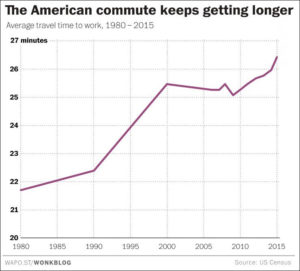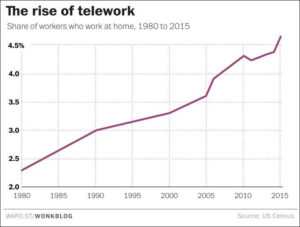
Graphic credit: Washington Post
Commutes have gotten longer in the past five years, reversing a ten-year tend in which they got shorter. So says the Washington Post based on the latest American Community Survey and Gallup polling data.
Even more discouraging for anyone hoping for less congestion, less gasoline consumption, fewer CO2 emissions and better public health, extreme commuting of 90 minutes are more is increasingly the most rapidly of all (by 8% in 2015 compared to the year before) while the shortest commutes (less than five minutes) actually declined 2%.
The Washington Post data is national, and we cannot assume that the same trends are being replicated here in Virginia. In a cursory search this morning, I could not find long-term trend numbers for Vehicle Miles Traveled (VMT) in the Old Dominion but Virginia Department of Transportation data indicates that inhabitants drove 2.0% more in 2015 than in 2014 — 226.4 million miles. One year may or may not mark a trend.

Graphic credit: Washington Post
If there’s any consolation in the numbers, it’s that telecommuting continues what seems to be a slow, steady rise. This trend does not seem be correlated, however, with length of commutes or vehicle miles traveled. Instead, the persistence of the trend probably reflects continued improvements to technology, increased deployment of broadband and growing acceptance of telecommuting in the workplace.
Longer commutes were not supposed to happen. Cities were revitalizing, suburbs were urbanizing, Millennials were shunning automobiles, developers were building more walkable communities, and states were investing in mass transit. But commuting defied expectations. The American people have confounded the experts and pundits (including me).
The Washington Post quotes Brookings Institution researcher Adie Tomer as saying suggesting that jobs are de-densifying, forcing people to drive longer distances, and suburban jurisdictions continue to develop low-density housing. Assuming that analysis is correct, the question is why. Frankly, I haven’t been following the urban-development blogs like I used to, so I don’t know what spin the Smart Growth people are putting on the data. And, sadly, no one in Virginia seems to be taking much notice.
Update: I corrected the percentage increase for Vehicle Miles Traveled in Virginia between 2014 and 2015. The correct percentage increase is 2%. Hat tip to alert reader Carol Bova.


